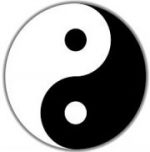 The Yin Yang symbol, or Taijitu, consists of black representing yin and white representing yang. It is a symbol that reflects the inescapably intertwined duality of all things in nature, a common theme in Taoism. No quality is independent of its opposite, nor so pure that it does not contain its opposite in a diminished form: these concepts are depicted by the vague division between black and white, the flowing boundary between the two, and the smaller circles within the large regions. Ref: Wikipedia: the free encyclopedia .
The Yin Yang symbol, or Taijitu, consists of black representing yin and white representing yang. It is a symbol that reflects the inescapably intertwined duality of all things in nature, a common theme in Taoism. No quality is independent of its opposite, nor so pure that it does not contain its opposite in a diminished form: these concepts are depicted by the vague division between black and white, the flowing boundary between the two, and the smaller circles within the large regions. Ref: Wikipedia: the free encyclopedia .
The following is a synopsis of the ancient philosophies obtained from the following
publications :
- Tai Chi for Beginners by Eng Chor Khor
- Art of Moving Meditation by Eng Chor Khor
- Tai Chi the Way to a Healthy Life by Gary Khor
- Tai Chi Qi Gong for Stress Control and Relaxation by Gary Khor
(all available from your instructor)
Ancient China
During the Yellow Emperor’s peaceful rule, around 3000 years ago, the Chinese practiced deep abdominal breathing exercises (Tu Na Kung) and gentle physical exercises (Tao Yin Kung) to improve their health. The I Ching or The Book of Change, written before 1000 BC, is at the heart of Chinese wisdom and is a guide to divination, seeking to rationalize the mysteries of the universe. “Change” itself is considered the most powerful force in the universe and is not “accidental”, but the result of the interaction between the two complementary forces: yin and yang. The concepts outlined in the I Ching are still studied today and many translations are available in book shops. The yin and yang symbol used in the Celestial Tai Chi logo shows that they have a complementary relationship and a small part of the black yang is found in the yin and vice versa. From the interaction of yin and yang arose the Five Elements Theory: wood, fire, water, earth, and metal. The famous Chinese philosopher Lao Tzu (604 BC) taught the doctrine of Tao or Naturalism which teaches that we must yield to the laws of nature which are constantly changing. The movements of Tai Chi have been influenced by both the I Ching and the philosophy of Lao Tzu.
Early Imperial China
The first record of Chinese exercises has been depicted on a silk scroll found in a tomb. These are the Tao Yin exercises which often imitate the physical movements of animals and were found to be beneficial to health. The Chinese doctor, Hua To (AD 200), observed the movements of the monkey, tiger, deer, bear and bird and developed the Tao Yin exercises to synchronize with breathing exercises – called the Play of the Five Animals.
Classical Imperial China
In AD 600 Ta Mo, a Buddhist monk from India, became the abbot of the Shaolin Temple. He found the monks in poor mental and physical condition and instigated an exercise and breathing regime utilizing both Chinese and Indian practices. He also incorporated martial arts techniques into this program and the monks were able to form a system of weaponless self-defence. The Shaolin Temple monks gained a reputation for mental and physical discipline which continues until this day. The styles developed by the Shaolin monks were exported to Korea and became Tae Kwon-Do, and to Japan, becoming Karate, Judo, Jujitsu and Aikido.
Chan Sang Fong, who lived during the Song dynasty (AD 960-1279), is accredited as being the founder of Tai Chi. He was a Taoist who, although he studied the external martial arts at the Shaolin Temple, developed the internal martial art of Tai Chi which encompassed the ‘way of nature’ taught in Taoist philosophy after having a dream about a fight between a snake and a crane.
Chang San Fong studied the nature and movements of animals and integrated sequences of movements with the Five Elements Theory (wood, fire, water, earth and metal represented by 5 directions – forward, backward, left, right and centre in Tai Chi) and the yin and yang concept in the I Ching. Yin represents, for example, soft, internal, night, stillness and passiveness whilst yang represents hard, external, day, activity, activeness and in Tai Chi, yin and yang means empty foot and solid foot, stepping forward and stepping backwards, moving hands up and down, breathing in and out.
Later Imperial China
The practice of Tai Chi moved away from the Taoists into the hands of martial arts families and Chen Bu (AD 1368) of the Chen Village (Chenjiagou), Henan was the source of the origin of the Chen Style Tai Chi as we know it today. Yang Lu Ch’an (AD 1799) studied and modified the Chen Style and developed the Yang Style Tai Chi, a form of which is the basis for the College’s 108-movement Traditional Yang Style Tai Chi. Other Tai Chi styles such as the Wu, Wu/Hao, and Sun Styles have also been developed.
Modern Era
Tai Chi has been spread world-wide by Chinese Masters and has gained popularity as the western world recognizes its powerful health benefits. Modern National Styles of Tai Chi have been developed for competitions and include the Beijing 24, Beijing 42 and Beijing 48 Styles.

